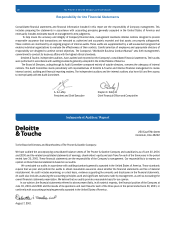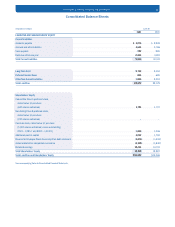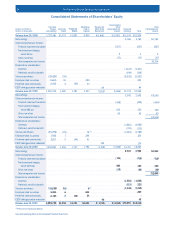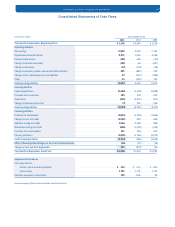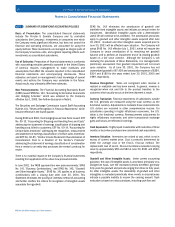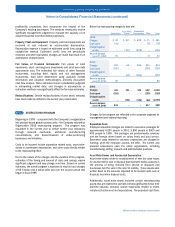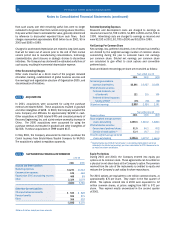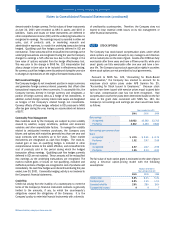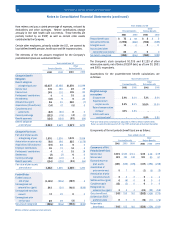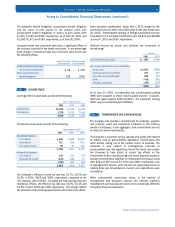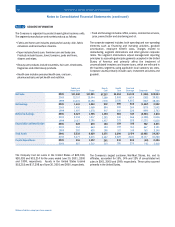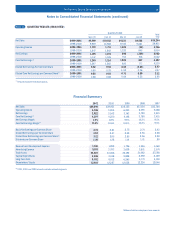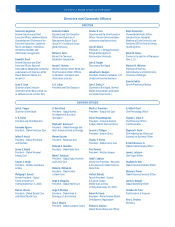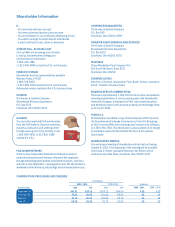Proctor and Gamble 2001 Annual Report Download - page 32
Download and view the complete annual report
Please find page 32 of the 2001 Proctor and Gamble annual report below. You can navigate through the pages in the report by either clicking on the pages listed below, or by using the keyword search tool below to find specific information within the annual report.
Notes to Consolidated Financial Statements (continued)
The Procter & Gamble Company and Subsidiaries
Millions of dollars except per share amounts
of creditworthy counterparties. Therefore, the Company does not
expect to incur material credit losses on its risk management or
other financial instruments.
NOTE 7 STOCK OPTIONS
The Company has stock-based compensation plans under which
stock options are granted annually to key managers and directors
at the market price on the date of grant. Grants after 1998 are fully
exercisable after three years and have a fifteen-year life, while prior
years’ grants are fully exercisable after one year and have a ten-
year life. The Company issues stock appreciation rights in countries
where stock options are not permitted by local governments.
Pursuant to SFAS No. 123, “Accounting for Stock-Based
Compensation,” the Company has elected to account for its
employee stock option plans under APB Opinion No. 25,
“Accounting for Stock Issued to Employees.” Because stock
options have been issued with exercise prices equal to grant date
fair value, compensation cost has not been recognized. Had
compensation cost for the plans been determined based on the fair
value at the grant date consistent with SFAS No. 123, the
Company’s net earnings and earnings per share would have been
as follows:
The fair value of each option grant is estimated on the date of grant
using a binomial option-pricing model with the following
assumptions:
denominated in foreign currency. The fair values of these instruments
at June 30, 2001 were recorded as $94 in assets and $101 in
liabilities. Gains and losses on these instruments are deferred in
other comprehensive income (OCI) until the underlying transaction is
recognized in earnings. The earnings impact is reported in either net
sales, cost of products sold, or marketing research and
administrative expenses, to match the underlying transaction being
hedged. Qualifying cash flow hedges currently deferred in OCI are
not material. These amounts will be reclassified into earnings as the
underlying transactions are recognized. During the year the Company
charged to earnings a $15 after-tax loss due to the change in the
time value of options excluded from the hedge effectiveness test.
This was prior to the change in SFAS No. 133 interpretation that
allows change in time value to be included in effectiveness testing.
No currency cash flow hedges were discontinued during the year due
to changes in expectations on the original forecasted transactions.
Net Investment Hedging
The Company hedges its net investment position in major currencies
and generates foreign currency interest payments that offset other
transactional exposures in these currencies. To accomplish this, the
Company borrows directly in foreign currency and designates a
portion of foreign currency debt as a hedge of net investments. In
addition, certain foreign currency interest rate swaps are designated
as hedges of the Company’s related foreign net investments.
Currency effects of these hedges reflected in OCI produced a $460
after-tax gain during the year, leaving an accumulated net balance
of $577.
Commodity Price Management
Raw materials used by the Company are subject to price volatility
caused by weather, supply conditions, political and economic
variables and other unpredictable factors. To manage the volatility
related to anticipated inventory purchases, the Company uses
futures and options with maturities generally less than one year and
swap contracts with maturities up to five years. These market
instruments are designated as cash flow hedges. The mark-to-
market gain or loss on qualifying hedges is included in other
comprehensive income to the extent effective, and reclassified into
cost of products sold in the period during which the hedged
transaction affects earnings. Qualifying cash flow hedges currently
deferred in OCI are not material. These amounts will be reclassified
into earnings as the underlying transactions are recognized. The
mark-to-market gains or losses on non-qualifying, excluded and
ineffective portions of hedges are recognized in cost of products sold
immediately. No cash flow hedges were discontinued during the year
ended June 30, 2001. Commodity hedging activity is not material to
the Company’s financial statements.
Credit Risk
Credit risk arising from the inability of a counterparty to meet the
terms of the Company’s financial instrument contracts is generally
limited to the amounts, if any, by which the counterparty’s
obligations exceed the obligations of the Company. It is the
Company’s policy to enter into financial instruments with a diversity
$3,763
3,683
$2.75
2.69
2.59
2.53
Years ended June 30
2001 2000 1999
Net earnings
As reported
Pro forma
Net earnings per common share
Basic
As reported
Pro forma
Diluted
As reported
Pro forma
$3,542
3,363
$2.61
2.47
2.47
2.34
$2,922
2,612
$2.15
1.92
2.07
1.85
30
5.4%
1.5%
26%
7
Options Granted in
Years ended June 30
2001 2000 1999
6.0%
1.5%
28%
9
5.8%
2.0%
26%
9
Interest rate
Dividend yield
Expected volatility
Expected life in years


